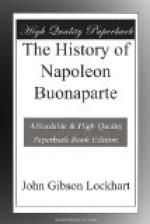The fire was tremendous: once more the French gave way. Napoleon himself, lost in the tumult, was borne backwards, forced over the dyke, and had nearly been smothered in the morass, while some of the advancing Austrians were already between him and his baffled column. His imminent danger was observed: the soldiers caught the alarm, and rushing forwards, with the cry, “Save the general,” overthrew the Germans with irresistible violence, plucked Napoleon from the bog, and carried the bridge. This was the first battle of Arcola.
This movement revived in the Austrian lines their terror for the name of Buonaparte; and Alvinzi saw that no time was to be lost if he meant to preserve his communication with Davidowich. He abandoned Caldiero, and gaining the open country behind Arcola, robbed his enemy for the moment of the advantage which his skill had gained. Napoleon, perceiving that Arcola was no longer in the rear of his enemy but in his front, and fearful lest Vaubois might be overwhelmed by Davidowich, while Alvinzi remained thus between him and the Brenta, evacuated Arcola, and retreated to Ronco.
Next morning, having ascertained that Davidowich had not been engaged with Vaubois, Napoleon once more advanced upon Arcola. The place was once more defended bravely, and once more it was carried. But this second battle of Arcola proved no more decisive than the first; for Alvinzi still contrived to maintain his main force unbroken in the difficult country behind; and Buonaparte again retreated to Ronco.




